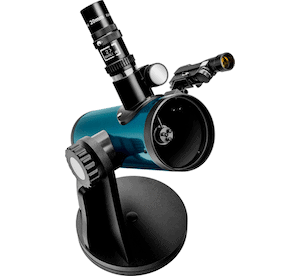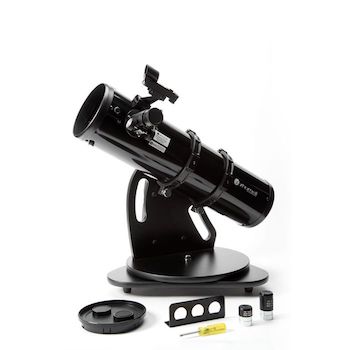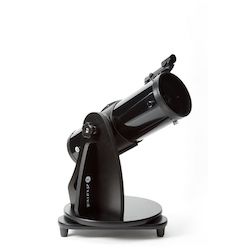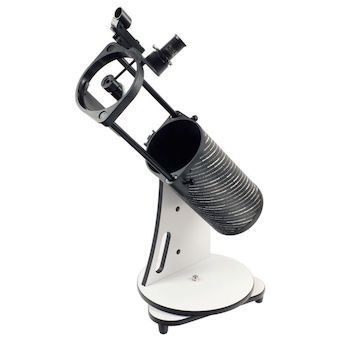There are lots of telescopes marketed towards children, and while a few of these are good, the sad truth is that many of them are absolute garbage. So often, parents will excitedly watch their kids open their brand new telescope on their birthday or Christmas, but then watch as it becomes disused in the basement. How can we tell apart the hobby-killers from the genuinely good telescopes? The best way to avoid disappointment is to do plenty of research beforehand, and never trust Amazon reviews. In selecting the best telescope for a child in particular, there are some extra important steps to follow.
Steps to Follow While Getting That First Telescope For Your Kid
Step 0: Understand basic terminology
- Objective: The primary image-forming element of the telescope.
- Aperture: The diameter of the objective.
- Eyepiece: An accessory added to the telescope to form an image, using lenses.
- Refractor: A telescope using lenses for the objective and the eyepiece.
- Reflector: A telescope using mirrors, with the only lenses being in the eyepiece.
- Catadioptric: A telescope using both mirrors and lenses, usually in the form of a reflector with corrector lenses.
- Focal Length: the distance between the objective and the point where an image is formed, and in many designs, this is approximately the length of the telescope tube.
Step 1: Identify Hobby-Killers
Hobby-killers are the things to avoid. They have awful optics, awful accessories, and awful mounts. These are often referred to as “department store refractors,” but reflectors can enter this category as well. Some such telescopes are sold by reputable or well-known brands. Celestron, Meade, and Orion all sell these poorly designed telescopes, and sometimes these brands partner with other reputable educational organizations like National Geographic or the National Parks Foundation to sell branded telescopes that are really no good. The constant in these telescopes is that they are usually long, thin tubes, sometimes with singlet plastic lenses, and they have a thin, shaky tripod with a wobbly mount. They’re sold because they look like what the popular conception of a “real” telescope looks like. Avoid these!
For a cheap telescope, you’re not going to get a good quality product if you go for something that is pretending to be a serious observing instrument—it puts all the effort into looking good without actually being good.
If you must get a refracting telescope—and they are seldom worth the price when bought cheap—make sure it uses an achromatic doublet instead of a single glass lens at the front. Otherwise, the color fringing will be unmanageable.
Step 2: Is your child ready for their own telescope?
Using a telescope requires four things which children tend to lack, and one thing which many have in excess: fine motor skills (for aiming and pointing the telescope). Concentration, patience, and abstract thinking (to understand how the telescope works and to keep them from getting bored trying to find a difficult object) and a passion for the night sky (why else would you want to look through a telescope?)
A telescope is not a thrilling, action-packed toy. It’s calm, slow, and steady, with occasional bursts of excitement. Its views are seldom truly spectacular from the perspective of a layperson—even the best nebula in the sky boils down to a fuzzy mass of gray gas surrounded by stars. It requires fine control to operate, especially at high magnifications, and young kids tend to lack that. Very young children struggle to even look through a telescope, unsure of how to place their eye in the eyepiece and with no understanding of what they’re looking for.
At around 6 or 7, kids start to actually be interested in looking through telescopes. Before that age, in my experience, kids don’t really seem to have much interest in looking through a telescope. They are often shy at star parties and observatory sessions, which is part of it, but younger kids tend to just put their eyes up to the telescope and say “uh huh” when you ask them about whether they saw anything, whether they actually saw it or not.
A 10 year old, maybe 8 or 9, is about the age when observational astronomy becomes a realistic activity for a child. Before that age, a parent is really getting themselves a telescope and using it with their child. After 10 years old, a child may be able to set up and use a telescope all by themselves.
However, just because a kid is too young to use a telescope all by themselves doesn’t mean they won’t get a lot out of using a telescope with guidance and partnership from their parent or an older sibling.
Step 3: Telescope or Binoculars?
Binoculars are unsteady, and often kids want a telescope.
A pair of comfortable binoculars for an adult might weigh 2 lbs, providing an aperture of 50 or 60 millimeters and a magnification of 8x or 10x. But even then, manually holding binoculars can be uncomfortable after a while, and that’s with adult arms. Kids will find 2lb binoculars too heavy, so something of about 1lb will be more reasonable. But that will provide a smaller aperture, dimmer views, and possibly lower magnifications.
A monocular can be half the price and half the weight of a comparable pair of binoculars, but like the binoculars, they can still be unsteady. And children tend to have even less steady arms to begin with.
A cheap, small pair of binoculars may hold a child’s interest while you’re setting up a larger telescope, and an older kid might get something out of using it to scan the starry regions of the milky way at night or look at the phases of the Moon, but I don’t think they’re nearly as good a starting point for children as they are for an adult. A large part of this is that, while they’re good for large deep sky targets–star clusters, nebulae, even some galaxies–they barely show detail on the Moon and seldom show anything on the planets. Also, sometimes a kid wants a real telescope, and a pair of binoculars won’t impress them.
If you are going to get a larger pair of binoculars, a photo tripod and an appropriate adapter for the binoculars are essential for a child’s use. But if you don’t already have the tripod, a decent sized one added to the cost of the binoculars might approach the cost of a comparable telescope.
A telescope can provide much higher power than a pair of binoculars, and, if mounted on a sturdy mount, they’re much easier to hold steady. Thus, even a low magnification can split double stars, reveal granularity in star clusters, show the moons of Jupiter, and hint at the elongated ringed shape of Saturn.
Step 4: Weight and Cost
The telescope weight for a child should be no more than 16 lbs for the child to carry the telescope outside by themselves. For a smaller child, 8 lbs is more comfortable. This is based on recommendations for the maximum safe weight of a child’s backpack: Child’s weight x 0.15
I recommend no more than 350 dollars. No less than 50.
A telescope can be a very costly instrument, and generally speaking, 200–350 dollars is the price to pay for the minimum serious observing instrument. But $350 is a lot of money, and especially for what might amount to a toy for a child, a price closer to $100 would be the preference of many parents. The good news is that many telescopes, even some pretty serious ones, sell for less than $350 nowadays, as we live in a time of unprecedented telescope availability.
However, while telescopes are getting cheaper, beware of the absurdly cheap. With optics, you do get what you pay for. I say no less than $50, but realistically you should go no lower than 70 or 100. 50 dollars happens to be the price of the Celestron FirstScope, the cheapest telescope that’s worth using. All other telescopes at that price or cheaper are hobbykiller refractors.
If you have a budget of more than 350 dollars, there are lots of very nice telescopes for adults, but few that satisfy the needs of a children’s telescope. A $1,000 apochromatic refractor travelscope on a smooth portable altaz mount might be lightweight enough and easy to use, but it’s a hell of a thing to have a child lose or break!
Step 5: Ease of use
The telescope must have a sturdy, easy-to-operate mount.
This disqualifies German equatorial mounts as well as cheap fork-of-doom mounts supplied with department store refractors. The ideal mount would be a dobsonian mount, but a photo tripod style mount could work too. Mounts should not have locks, clutches, or fiddly knobs to worry about.
There are two types of computerized mounts available for beginner telescopes: GoTo telescopes and PushTo telescopes. Both make use of hand controllers and require a setup procedure. GoTo scopes will find objects for you and track the sky, so they may seem like a good choice for a beginner, especially a child. However, this can be counterproductive. Most GoTo models require a fairly slow and boring setup, which has to be done fairly precisely, and lots can go wrong, requiring potentially 30 minutes or more of troubleshooting before observing can begin. They’re also much more expensive!
PushTo could work, but I think their best utilization is in their Identification feature, where if a kid finds an object, they can identify it using the push-to system. This has some value, although learning to read star maps is a useful skill to learn, both as a problem-solving and practical skill, and for astronomy in particular.
Step 6: Reflectors, Refractors, Collimation, and Aberration
There are two major optical designs. Reflectors, which use a curved mirror at the back, and Refractors, which use a lens at the front.
The lens in a refractor must be an achromatic doublet (or an apochromatic triplet, which you’re not going to find cheap), or there will be severe chromatic aberration (false color fringing).
Meanwhile, the mirror on a reflector must be a parabolized mirror, as the cheaper spherical mirrors have spherical aberration. Both spherical and chromatic aberration reduce contrast and sharpness when viewing at high powers. In the extreme, they can even show up at low powers.
One important concern is collimation. The mirrors in many reflectors can become misaligned when bumped, and so they will need to have their mirrors realigned periodically. This is not a job for a child, or for a technically unsavvy adult, but it is not too difficult after some practice. Reflectors that have fast focal ratios (explained in Step Eight) must be collimated more often and more precisely, while longer reflectors may go longer periods before being adjusted.
Some entry-level reflectors have had their mirrors permanently locked in place, and thus do not need collimation unless they came out of the factory miscollimated.
Refractors typically do not need collimation unless they’re badly designed, which is an important consideration if you don’t feel that you or your child can learn to do the collimation. (An elementary-aged child almost certainly wouldn’t be able to do a collimation, but a middle or high schooler could.)
The main trouble with a refractor is that they typically come on very cheap alt-az fork mounts, which can be very frustrating and wobbly, or else they come on equatorial mounts, which are not good for a beginner or a child at all. The other problem is that, for the aperture and optical quality, reflectors are much cheaper to make than refractors. Therefore, most cheap refractors are smaller than equivalent reflectors, or they have especially poor optical quality.
Step Seven explains how the focal ratio meshes with aberration.
Step 7: Planets or Starry Scanning?
One thing that is important to mention is that the focal ratio of a telescope determines an important aspect of how it will be used. Short telescopes are called “Rich Field Telescopes” because they can easily reach low magnifications and wide fields of view. This makes them very excellent for scanning the sky (especially in a darker suburban/rural sky) and observing Deep Sky Objects (Galaxies, Nebulae, and Star Clusters). However, they typically struggle to get to the higher magnifications required for planetary viewing without expensive eyepieces or a good Barlow magnifier lens. Long telescopes, meanwhile, are great for lunar and planetary viewing because they provide more magnification. However, if they’re very long, they can be so far zoomed in that they struggle to get to low powers and wide fields of view without modifying the telescope and using expensive eyepieces. This means it’s much harder to find and observe faint deep-sky objects.
To find the focal ratio, simply divide the focal length in mm by the aperture diameter in mm. A typical rich field telescope has a focal ratio of between 4 and 6, while a planetary scope has a focal ratio of between 8 and 15.
Note that aperture is still very important—both for light gathering on faint DSOs and for resolution on planets. In a reflector with a parabolic mirror, aperture is definitely more important than focal ratio, as it determines the maximum useful magnification. In refractors and spherical reflectors, the focal ratio becomes much more important, as longer focal ratios reduce aberrations. Short-focus refractors and spherical reflectors can be good deep sky scanners, but they’re awful on planets and the Moon, while long-focus refractors and spherical reflectors can be very good on planets, but due to being zoomed in, they’re not great on the deep sky.
Reflectors with spherical mirrors, as well as achromatic refractors, need longer focal lengths for planetary and lunar viewing because of spherical and chromatic aberration, respectively. That is, for those scopes with focal ratios of below 8 or so, aberrations will reduce the contrast and sharpness of the image no matter what expensive eyepieces you buy.
A reflector with a parabolic mirror will not have aberrations at any focal ratio, so high power can be achieved almost as well with a short parabolic reflector as with a long parabolic reflector, if the correct short-focus eyepieces are used.
A refractor will have chromatic aberration, which limits high power viewing at any focal ratio below 10 or so, but 6-8 can be reasonable.
Middle school and high school age kids have similar needs in beginner telescopes to layperson adults, simply adjusting for the maximum weight of the telescope. Any of the telescopes discussed here can make a decent beginner instrument for anyone, price dependent, but especially so for children.
The Verdict:
The best type of telescope for children that fits all of these criteria is a tabletop Dobsonian reflector.
A Dobsonian telescope is a Newtonian reflector, using a curved primary mirror and a flat, angled secondary mirror, placed on a cheap, sturdy wooden rockerbox and lazy susan. It was pioneered in the 70s by amateur telescope maker John Dobson as a way to cheaply scratch-make very large, user-friendly telescopes. Tabletop Dobsonians are shorter, usually smaller, and, instead of using a rockerbox, they use an altitude arm with an adjustable bearing.
Tabletop Dobsonians are very portable, and they offer by far the best bang for your buck. They’re also portable enough that, when it comes time to upgrade, they’ll still serve a niche as portable travel telescopes.
Best Kid’s Telescope Recommendations
I have made suggestions across a range of budgets, so you can begin to narrow down which one(s) might be appropriate for your family and your budget. There are certainly more expensive systems, but those would be great starter scopes for your family that could eventually be taken over by your child.
Under 10 Years Old
For those under 10, the best telescopes for kids listed below are all light enough and compact enough that a 7-to-10-year-old should be able to handle it, physically on their own when they are ready.
CHEAPEST RECOMMENDATION
1. Cometron FirstScope or Orion FunScope

On High Point Scientific’s site
Our thoughts
The default version, Celestron FirstScope, has awful eyepieces, and the spherical mirror can’t focus light properly at high powers, but it’s not so bad for scanning the sky. The Cometron version of FirstScope has better eyepieces and is a better deal overall, despite being slightly more expensive. Orion’s FunScope, the most expensive of the three FirstScope offerings, uses the same mirrors but includes the best accessories.
BEST FOR KIDS AROUND $100
2. Orion SkyScanner or Zhumell Z100
8/10
Very good, but not quite great

On High Point Scientific’s site
Our thoughts
The Orion SkyScanner 100 or Zhumell Z100 provides a much better telescope than the FirstScope at a decent price. They are very much like the FirstScope, but with a larger mirror that is figured as a true parabola rather than a sphere, so spherical aberration is minimized. They also include decent eyepieces. The Z100 has a slightly better focuser position than the SkyScanner, but their optics and accessories are identical. Of the two, either will work fine, but the Z100 is slightly better. If you find them for the same price, pick the Z100.
BEST FOR KIDS AROUND $150
3. Zhumell Z114 or Orion Starblast 4.5
9/10
Nearly flawless

On High Point Scientific’s site
Our thoughts
The Zhumell Z114 (also the practically identical Orion StarBlast 4.5 Astro) reflector is the instrument of choice for the vast majority of library loaner telescopes. It provides high light-gathering power, ease of use, and more precise optics than the Orion SkyScanner/Zhumell Z100. It’s a little smaller than our $200 recommendation, Heritage 130P, but it will hold collimation better, so it won’t need to be adjusted unless it’s been bumped or banged. It will need aftermarket accessories to reach full magnification to see details on planets, though. The Zhumell Z114 is often sold for considerably less than the StarBlast 4.5 Astro, but you can often find the StarBlast 4.5 Astro discounted. Go for the cheapest of the two. Note that I do not recommend the EQ-mounted version of the StarBlast 4.5 for children.
BEST FOR KIDS AROUND $250
4. SkyWatcher Heritage 130P
9/10
Nearly flawless

On High Point Scientific’s site
Our thoughts
The SkyWatcher Heritage 130P, also sold as the AWB OneSky 130, is probably the best bang for your buck of any cheap telescope you can buy. It is a tabletop dobsonian with a 5 inch aperture, decent eyepieces, and it is very close to a serious observing instrument. It struggles to get very high magnification views of the planets and the Moon, but it excels at deep sky objects. An expensive high-power eyepiece or a decent-quality barlow lens can bring the magnification up high enough to see details on planetary surfaces and close-up views of lunar craters. One problem it presents to a child, however, is that due to it using a collapsible tube, it may need a collimation nearly every time it’s used, as the mirrors will be in slightly different alignment. This procedure is not very difficult for an adult after one or two tries, but I wouldn’t make a child do it. Without collimating, the telescope won’t deliver truly sharp views, but it’s entirely possible that you won’t even notice the difference unless the telescope gets banged.
We usually recommend Zhumell Z130 to adults when compared with Heritage 130P. However, at 21 lbs, it is not within the constraints set by the weight requirement for children, being almost as heavy as the StarBlast 6!
BEST FOR KIDS AROUND $250
5. Orion SkyQuest XT4.5
8/10
Very good, but not quite great

On Orion’s site
Our thoughts
Probably the best out of all of these telescopes for children, the Orion SkyQuest XT4.5 is a miniature version of a full-scale dobsonian, suitable for children to sit with or stand and look at. An adult would prefer to enhance the height of the telescope by using a stool or a sturdy crate or box.
The fully assembled telescope is fairly heavy at 22 pounds, but if the optical tube and the dobsonian mount are taken out separately, a child can manage–the optical tube has a handle to facilitate this. Its main advantage over the StarBlast 4.5 and the Zhumell Z130 is its longer focal length, which allows the same eyepiece focal lengths to deliver a higher magnification, making high-power planetary and lunar views much more attainable. SkyQuest XT4.5‘s eyepieces are higher quality 4-element eyepieces compared to the StarBlast and Z130’s 3-element eyepieces. The base requires adult assembly at first, but a child can take the telescope on and off the base and adjust the tension springs on their own.
If you prefer an even more expensive one,
- $350+ will give you a full-size 5-inch or 6-inch dobsonian. While these are very effective telescopes and easy to use even for children, at this size they tend to be unwieldy and too heavy for children to carry on their own.
- $350 will get you an Orion StarBlast 6” tabletop dobsonian telescope. This is a tabletop dobsonian, but it weighs 23 pounds, so while it may be an excellent beginner’s telescope, it isn’t such a good choice for a child.
Over 10 Years Old
Today’s average 10-year-old has mastered the use of a smartphone, video games, and likely a computer or tablet. While manual scopes are always appropriate and recommended for adults, a responsible pre-teen may be able to operate a computer-assisted PushTo or GoTo telescope system with some initial help from an adult to learn the system. A lot depends on the child. In some cases, they may pick it up faster than you. If this sounds like your kids’ case, we recommend you read our Best Computerized Telescopes Guide and pick one based on your budget.
If not, we have the “Best Telescope Guide,” which consists of mostly manual telescope recommendations. They would be far superior in providing quality views when compared to similar priced GoTo/Pushto computer-controlled telescopes, and we would always recommend them in normal circumstances. GoTos are typically recommended only for budgets of $1000 or above.
Preparing your child to use a telescope
If you’re going to get your kid a telescope, they must know a few important pieces of safety information. First, they must never, ever, EVER look at the Sun with their telescope. It will blind them, or at least cause permanent and severe damage. Solar filters are available for telescopes, but I would only ever allow that to be used with serious adult supervision. Solar filters must cover the entire aperture of the telescope. Never ever use an eyepiece solar filter or a moon filter to observe the Sun.
They should also understand what objects look like through a telescope. They don’t look anything like the NASA pictures! Most things are grey and black. In a telescope, only some stars and the planets show color. Planets tend to be very small dots in a telescope, but you can usually see the rings of Saturn, the moons and cloud bands of Jupiter, the phases of Venus, and subtle details on the surface of Mars.
If your kid is very young, start them out by looking at the Moon. It’s bright enough that you’ll be able to see the Moon projected onto their faces. If that projected image isn’t right in their eyeball, then they can’t actually see the moon, and they’re lying if they tell you otherwise. Make sure their eye is centered in the eyepiece.
